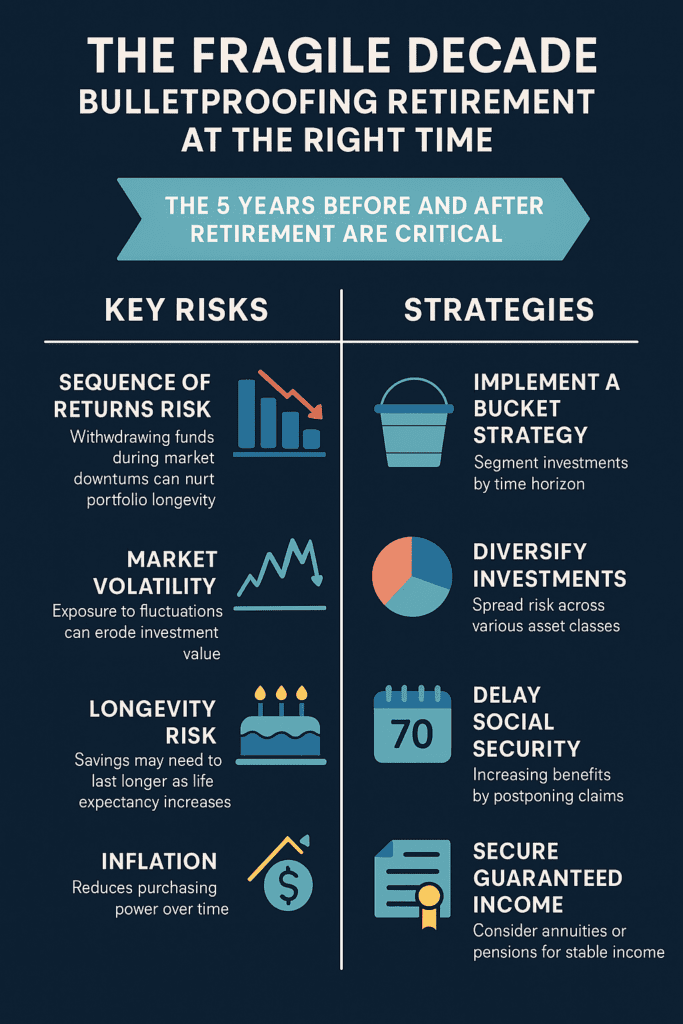Bulletproof Your Retirement Plan During the Critical Years

Retirement isn’t just a date on the calendar—it’s a financial turning point that can determine the comfort and security of your later years. But few people realize that the most vulnerable time in retirement planning isn’t during market crashes or economic shifts—it’s the 5 years before and after you retire.
This 10-year span, often called the fragile decade, can make or break your retirement success. In this article, we’ll explore why this period is so risky and how to safeguard your nest egg with smart, strategic planning that aligns with Google’s EEAT principles: expertise, experience, authoritativeness, and trustworthiness.
Why the Fragile Decade Matters
Imagine spending 30 years saving diligently for retirement, only to watch a significant portion of your savings evaporate in your first year out of the workforce. That’s not just stressful—it can permanently damage your financial future.
This risk is largely due to sequence of returns risk, which is the danger of withdrawing income during a market downturn early in retirement. Unlike when you’re accumulating assets, a loss during retirement withdrawals doesn’t allow your investments time to recover. You’re taking money out while values are low, locking in losses and reducing your ability to earn future gains.
Here’s why the fragile decade is so important:
- Pre-retirement (5 years before): Market losses here can reduce your total retirement savings—and you may not have enough time left in your career to rebuild them.
- Early retirement (5 years after): Losses during this time, combined with withdrawals, can deplete your savings faster than expected.
Real-World Impact of Market Timing
Let’s look at a simplified example.
Two retirees, both with $1 million saved, begin taking $50,000 a year in retirement income. Retiree A experiences positive market growth early in retirement, while Retiree B sees negative returns in the first three years. Even if both average the same return over time, Retiree B may run out of money years earlier than Retiree A.
That’s the danger of poor timing—and why proactive planning is essential.
Key Risks to Manage in the Fragile Decade
1. Market Volatility
Fluctuations in the stock market are unpredictable. A recession or bear market in the fragile decade can devastate portfolios without proper risk management.
2. Longevity Risk
People are living longer than ever. The longer you live, the more income you’ll need—sometimes for 30 years or more. Outliving your money is a very real concern.
3. Inflation and Rising Costs
Even modest inflation erodes purchasing power over time. Healthcare, housing, and long-term care costs often rise faster than general inflation.
4. Withdrawal Strategy Mistakes
Many retirees simply withdraw a flat percentage or dollar amount each year without adjusting for market conditions or needs. This approach can be dangerous during down markets.
5. Tax Exposure
As you begin withdrawing from retirement accounts like 401(k)s or Traditional IRAs, taxes can eat into your income more than expected—especially if tax rates rise in the future.
Strategies to Bulletproof Your Retirement Plan
The good news? There are tested ways to reduce these risks and create a more resilient retirement plan. Here’s how to start:

Now, let’s break down each strategy in more detail:
1. Segment Your Retirement Assets
Use a time-based bucketing strategy:
- Bucket 1 (0–5 years): Low-risk, liquid investments like cash equivalents and short-term bonds to cover near-term income needs.
- Bucket 2 (5–15 years): Moderate-risk assets that can grow over time but aren’t needed immediately.
- Bucket 3 (15+ years): Higher-risk, long-term investments to outpace inflation and provide income in later years.
- This system helps shield your income from short-term market swings.
2. Secure a Base Level of Guaranteed Income
Relying solely on market investments for retirement income is risky. Instead, create a base income floor using:
- Social Security
- Pensions
- Annuities with lifetime income guarantees
This approach ensures that essential living expenses are covered, regardless of market performance.
3. Delay Social Security Strategically
Waiting until full retirement age—or even better, age 70—to claim Social Security can significantly increase your monthly benefit. This is especially valuable if you’re concerned about longevity or reducing withdrawal pressure on your savings early in retirement.
4. Reevaluate Your Investment Allocation
In the fragile decade, it’s time to shift from growth-focused investing to risk-managed strategies. That doesn’t mean abandoning growth altogether—but it does mean rebalancing and reducing exposure to high-volatility assets.
Consider:
- Diversified portfolios with lower equity exposure
- Principal-protected vehicles
- Tactical asset allocation that adjusts based on market conditions
5. Have a Tax Strategy in Place
Work with a professional to determine the most tax-efficient withdrawal strategy. This could include:
- Roth conversions during lower-income years
- Tax-efficient drawdown strategies that coordinate withdrawals from taxable, tax-deferred, and tax-free accounts
- Using qualified longevity annuity contracts (QLACs) to delay required minimum distributions
6. Plan for Healthcare Costs
Healthcare can be one of your biggest expenses in retirement. Consider:
- Purchasing long-term care insurance or hybrid products
- Using Health Savings Accounts (HSAs) if you’re still eligible
- Planning around Medicare enrollment and supplemental insurance
Don’t Wait Until It’s Too Late
Most people assume retirement planning ends the day they retire—but that couldn’t be further from the truth. The decisions you make in the 5 years before and after retiring carry disproportionate weight and require careful consideration.
Even a well-funded retirement can be undermined without a proactive, defensive strategy in place during the fragile decade.
Final Thoughts: Put the “Plan” in Retirement Planning
Building a bulletproof retirement strategy is not about reacting to market headlines—it’s about having a proactive, informed game plan. This 10-year window is your opportunity to lock in peace of mind, ensure income security, and transition smoothly from accumulation to preservation and distribution.
The best way to start? Work with an experienced, fiduciary-based financial advisor who understands these risks and has solutions tailored to your goals and lifestyle.
Looking for Guidance?
If you’re seeking personalized advice, consider reaching out to a financial professional.. Get started by visiting our “Find a Financial Professional” section, where you can connect with someone directly. If you would like a personal referral for a first appointment, please call us at 877.476.9723 or contact us here to schedule an appointment with an independent trusted and licensed financial professional.
🧑💼Authored by Brent Meyer, founder and president of SafeMoney.com, with over 20 years of experience in retirement planning and annuities.
Disclaimer: This article is for educational purposes only and does not constitute financial advice. Consult with a qualified financial professional before making any retirement planning decisions.








